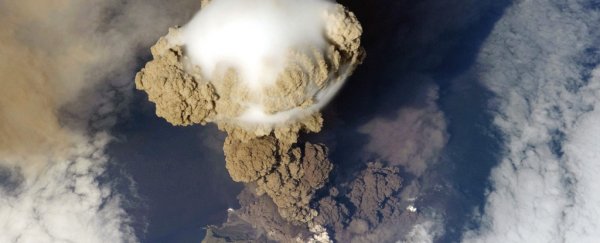It wasn't ash that killed the victims of volcano Vesuvius in Pompeii and Herculaneum in 79 CE. It wasn't lava. It was something called pyroclastic flows - extremely hot clouds of volcanic gas and debris that can move at insane speeds.
Pyroclastic flow speeds are so intense, they seem to defy the laws of physics, given the high static friction of volcanic particles. Now volcanic researchers have figured out how it works - those hot currents generate a layer of air at their base, over which they glide almost without friction.
"Here we show, through large-scale experiments and numerical multiphase modelling, that pyroclastic density currents generate their own air lubrication," the researchers explained in their paper. "This forms a near-frictionless basal region."
Given how deadly pyroclastic flows can be - moving up to 725 kilometres per hour (450 mph) at temperatures up to 1,000 degrees Celsius - studying them isn't exactly simple. Direct observations are out of the question, and their size and speed, seen in the below video, makes scaling them for a laboratory setting difficult.

But volcanologists are clever people, and a team worked out how to simulate pyroclastic flows in a laboratory at Massey University in New Zealand using a large-scale experimental setup.
They mined volcanic particles from the Taupo eruption in 232 CE, heated them up to as high as 130 degrees Celsius, and sent them barrelling down a 12-metre (40-foot) chute, 1,000 to 1,300 kilograms (2,200 to 2,870 pounds) per experiment.

This chute was equipped with sensors, including high-speed cameras, to observe the dynamics at play in the flow. As it turned out, within the flow there were extremely high shear rates - the rate at which layers in a fluid flow past each other.
When shear increases, so does air pressure; and when shear rates are at their highest, that pressure produces a cushion of air just above the ground, pushing particles away from each other, with denser volcanic dust layers sliding over the top of it.
"Once it is established, and this happens in just a few milliseconds," Gert Lube of Massey University told The Guardian, "this air film lubricates the pyroclastic flow somewhat in the same way as gas streaming through little holes in an air-hockey table lubricates the hockey puck."
The team then took this information and ran it through computer simulations at varying speeds and heights, including scales seen in real volcanic eruptions. They determined that basal air lubrication is "probable" in natural pyroclastic flows over most of the distance they travel, no matter the terrain.
It's a discovery that could aid in hazard assessment and mitigation by allowing more accurate calculations of pyroclastic flow speeds and runout distances. And it might not just be applicable to volcanic flows.
"Discovery of the air-lubrication mechanism opens a new perspective on the known extreme runout potential of these lethal currents," the researchers wrote in their paper.
"The efficiency of air lubrication in our comparably slow experimental flows suggests that it must be present in other types of long runout mass flows, including snow avalanches and fast-flowing landslides."
The research has been published in Nature.
